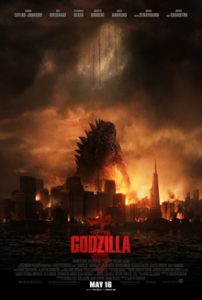 (SFX Magazine, Future Publishing)
(SFX Magazine, Future Publishing)
How do you solve a problem like Godzilla?
We’re not asking how you kill the King of Monsters. Don’t be silly; he shrugs off bullets, treads on tanks and eats nukes sunny-side up. And as the original 1954 film pointed out, it makes no difference if you do kill him; another Godzilla will be stomping along in a moment.
No, the problem is how you sell Godzilla in 2014. In Japan, his career went from the dead-serious first film to the Godzilla who did flying kicks and Highland flings in kitsch sequels, aimed at geeks and kids. In America, he was Scrappy Doo-ed by Hanna-Barbera’s toon Godzooky, and lobotomised in that Roland Emmerich film of which we will not speak again. Bits of Godzilla’s DNA were pinched by Jurassic Park (where do you think Ms. T-Rex learned her roar?), as well as by Cloverfield and Pacific Rim.
Gareth Edwards, a Nuneaton boy coming to blockbusters from the micro-budgeted Monsters, has grappled with Godzilla’s identity issues and charts a middle course through them, serious and silly. It won’t please everyone, and it’ll let critics bring down their “Dumb Monster Movie” hammers which Monsters dodged. The new Godzilla is heavy on wonder, but more sparing on the slambang spectacle than you’d have guessed. After a thriller-style first act, it keeps its humans down to the level of ant-level spectators.
The film is also slathered in culty, B-movie retro. You expect Edwards to pay his respects to the 1954 film, and he does, but he also writes a love-letter to the American SF flicks of the same decade. It makes sense. In interviews, Edwards has said that his love of SF was bound up with Hollywood films of this time, made before he was born. You can see his movie through 3D glasses on a massive cinema screen. But for viewers of Edwards’ generation (he was born in 1975), there are moments watching Godzilla when you feel you’ve returned to childhood and are watching a teatime vintage creature feature on BBC2.
The film’s most modern in its conspiracy-thriller first act. The witty opening credits have bits of top-secret text which get blacked out as soon as you try to read them. Following a disaster-film prologue at a Japanese nuclear power-station, we jump forward fifteen years. Naval officer Ford Brody (Aaron Taylor-Johnson) reluctantly goes to Japan to meet his estranged father Joe (Broken Bad’s Bryan Cranston), who’s been a conspiracy crank since the nuclear meltdown cost him his wife. If you’ve seen the trailers, you might think Cranston looked rantingly OTT. In the film, he’s believably raw and broken, and the one human who really registers.
Joe insists the true cause of the nuclear calamity was hidden, and drags Ford with him to the still-quarantined disaster zone. Their journey through the ruined, moss-grown town has shades both of reality – the Fukushima meltdown in 2011 – and modern apocalypse fantasies like the game The Last of Us. From then on, the story develops in ways you won’t expect, even if you’ve seen the trailers.
Godzilla eventually shows up, of course, and the action moves to Hawaii and mainland America, with an extended showdown in San Francisco. Is it good action? Blimey, yes. There are terrifically staged sequences on beaches, trains and bridges, with twists of their own; let’s just say a nifty new monster power is very effective against human technology. There are beautiful images of the king himself, roaring against backdrops of exploding airports or rearing up from the ocean with helpless battleships on his back (insert your ‘bigger boat’ joke here).
It’s not wall-to-wall action, though, and the bits in-between are the issue. The B-movie elements are visible from the start, but at first they’re balanced by the engaging thriller plot. But once the monster is on the table, the clichés emerge without a fig-leaf of concealment. A soldier quips that his job is to aim a missile’s pointy end at Godzilla. A wise Japanese scientist (Ken Watanabe) is at loggerheads with military brass over whether to respect nature or blow it up. There are no Joss Whedon witticisms, no broad turns from a Jeff Goldblum or a Ron Perlman. For today’s audiences, such characters could have eased the transit from the first act’s ‘real’ world to the preposterous one of the rest of the film.
But Godzilla has very much the mentality of a vintage creature feature, seeming pitched at the audiences mentioned earlier, at children and fannish true believers. There’s one beautiful cut in the film from monster mayhem to a peacefully dreaming child, implicitly appealing to our own inner infant. If there’s a specific film which Godzilla feels modelled on, it’s the 1953 version of War of the Worlds, down to the mise-en-scene of ruined cities, outmatched soldiers and hardware, and scary encounters in night-time country backwaters (with a great ‘Behind you!’ gag).
The human characters are largely reduced to trotting from location to location, helpless to direct events as Godzilla looms over everything. The last act gets you to cheer not the humans but the increasingly humanised Big G, a million-year old bruiser who’s majestically, roaringly pissed off, but who can tire, who might even lose, and who therefore has the capacity to be a hero. It’s likely many SFX readers have the mentality to buy into the film’s fantasy, one that is extremely silly, yet deep-rooted and transparently sincere up to a sublime, celebratory final shot. But whether Godzilla can earn blockbuster bucks for its studio is another question.
[amazon_link asins=’B00OCG4BIA,B00EXPOD9M’ template=’ProductGrid’ store=’anime04c-21′ marketplace=’UK’ link_id=’344c22a5-1227-11e9-a5a4-2d1e4e0d3fdd’]
